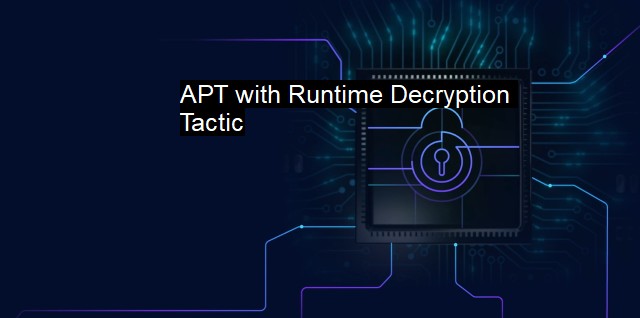What is APT with Runtime Decryption Tactic?
Explaining APT with Runtime Decryption—a Dangerous Tactic Employed by Advanced Cyber Attackers to Circumvent Antivirus Detection
The term "Advanced Persistent Threat (APT) with runtime decryption tactic" is a crucial concept in cybersecurity and antivirus fields. a tactic is a specific technique used in a wider strategy. In this context, the tactic refers to a method employed by an APT to decipher encrypted code at runtime, often utilized to bypass detection systems and penetrate through sophisticated security measures.The Advanced Persistent Threat (APT) refers to a concerted network assault in which an unauthorized person gains access to a network and stays undetected over an extended period. Unlike other types of attacks that are implemented for instantaneous gain, APT attacks target a specific entity. The main objective of APT attacks is to stealthily infiltrate a network, obtain sensitive data, and monitor the activities performed within that particular network.
A crucial factor that distinguishes APT from other threats is the level of sophistication employed, both in the means of attack and the plethora of tactics used to warrant long-term presence in the victim's network. The perpetrators often use zero-day exploits, targeted phishing schemes, and heap sprays, among other measures, to attain their goals.
These are not mere hit-and-run type exploits. APT attacks are often state-sponsored and motivated by significant strategic pursuits. This may consist of severe political, economic, or military motives. As one can anticipate, governments, defense contractors, and multinational corporations fall among the high-profile targets.
A common trait of these stealthy cyber-attacks is the implementation of encryption tactics, and specifically, runtime decryption. In simple terms, runtime decryption involves decrypting encrypted code when a program is running. This method has significant value for threat actors wishing to infiltrate networks undetected.
By encrypting the malicious code, threat actors can mask their code through Runtime Encryption. This kind of encryption can potentially bypass signature-based threat detection systems, including antivirus software, making the malicious script nearly invincible to typical antimalware applications. The code is only decrypted and executed at runtime, making it challenging for static and dynamic analysis tools to detect or analyze them.
Runtime decryption tactic provides a dual advantage—it hides the code as long as the process is not running and even when the process is running, it only reveals small parts of the code that is decrypted one section at a time.
These tactics encompass several techniques in their arsenal. One such technique may involve decrypting small segments of a malicious binary that encompasses a function or a branch of commands that can function independently. Further, after the just-decrypted code segment accomplishes its tasks, it may be re-encrypted, thus leaving no traces for discovery by most intrusive-detection or protective measures used conventionally.
Therefore, the success of an APT attack employing the runtime decryption tactic fundamentally depends on three conditional degrees. First, the ability to deliver the decryptable code or inject it into a legitimate process. Second, the adequacy of the encryption mechanisms ensuring the process remains invisible to security apparatus. Lastly, the success of the decrypted code to effect an elusive or concealing effect once it commences execution instructions.
The most effective ways to counter APT attacks with the runtime decryption tactic revolve around behavioral analysis and advanced threat protection measures. By implementing comprehensive, dynamic security systems with automated behavior-based recognition, organizations come to detect irregular activities in the network that enables quick identification and response to possible threats.
APTs with runtime decryption tactics present a significant and evolving challenge in the field of cybersecurity and antivirus software. Successfully mitigating these high-tech and strategized cyber threats necessitates robust and complex security measures, re-enforcing the arena's need for ongoing technology innovation and threat awareness.

APT with Runtime Decryption Tactic FAQs
What is apt with runtime decryption tactic?
Apt with runtime decryption tactic is a type of advanced persistent threat (APT) that uses encryption to hide its malicious activities. It uses techniques to bypass antivirus software and evade detection.How does apt with runtime decryption tactic work?
APT with runtime decryption tactic works by encrypting malware at runtime, making it difficult for antivirus software to detect. The encrypted malware is then decrypted when executed, allowing it to carry out its malicious activities undetected.What are the consequences of apt with runtime decryption attacks?
The consequences of apt with runtime decryption attacks can be severe, including data theft, system damage, and the compromise of sensitive information. The attacks can be difficult to detect and can remain undetected for long periods, allowing attackers to maintain access to systems and steal data over an extended period.How can organizations protect themselves from apt with runtime decryption attacks?
Organizations can protect themselves from apt with runtime decryption attacks by implementing layers of security controls, including advanced endpoint protection, intrusion detection and prevention, network segmentation, and access controls. Regular security assessments, vulnerability scanning, and employee training can also help identify and mitigate potential threats.| | A | | | B | | | C | | | D | | | E | | | F | | | G | | | H | | | I | | | J | | | K | | | L | | | M | |
| | N | | | O | | | P | | | Q | | | R | | | S | | | T | | | U | | | V | | | W | | | X | | | Y | | | Z | |
| | 1 | | | 2 | | | 3 | | | 4 | | | 7 | | | 8 | | |||||||